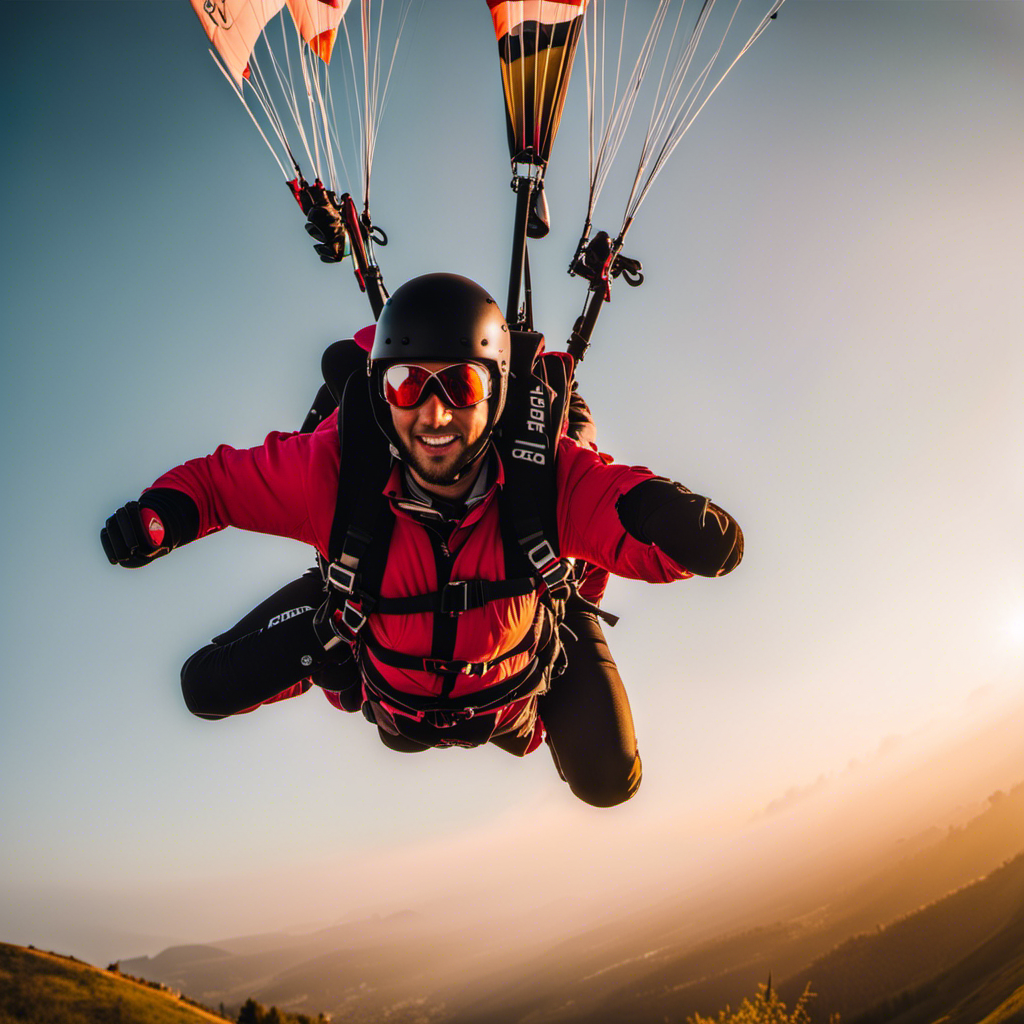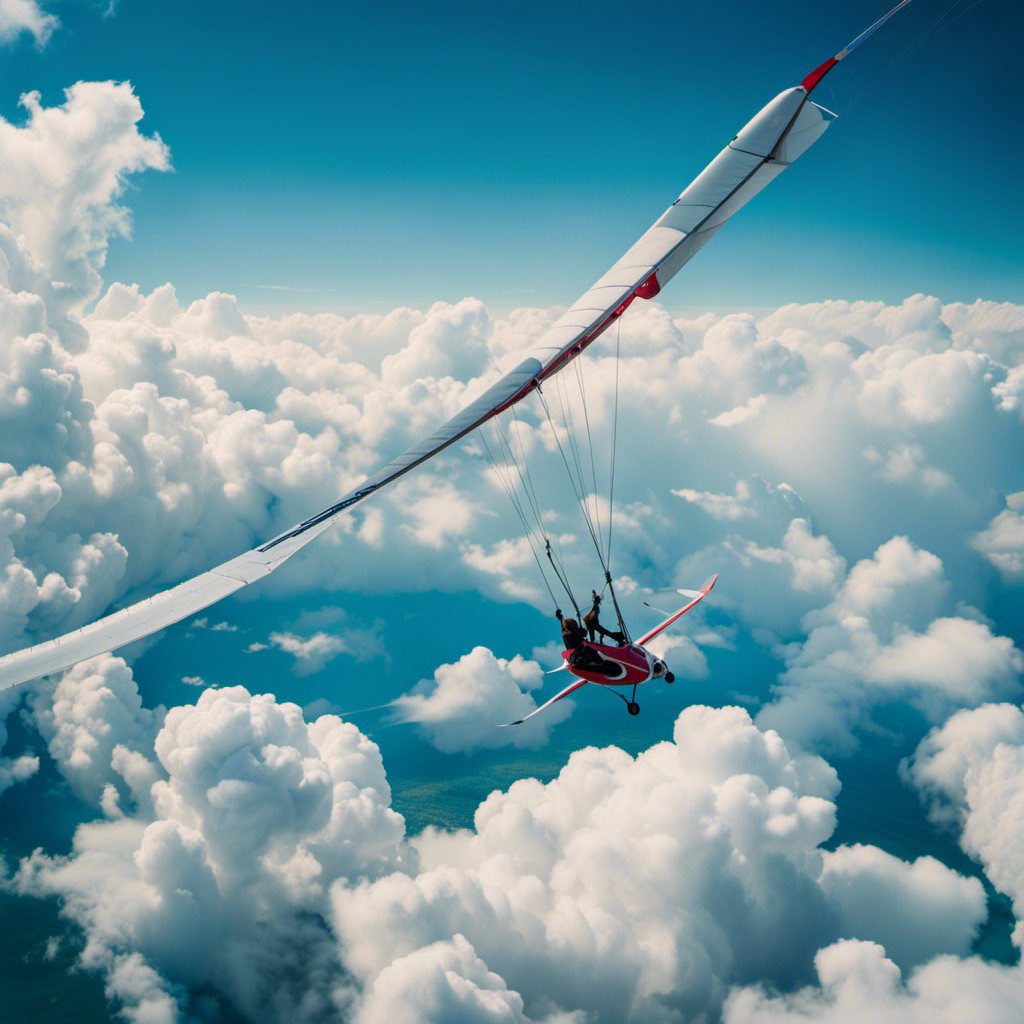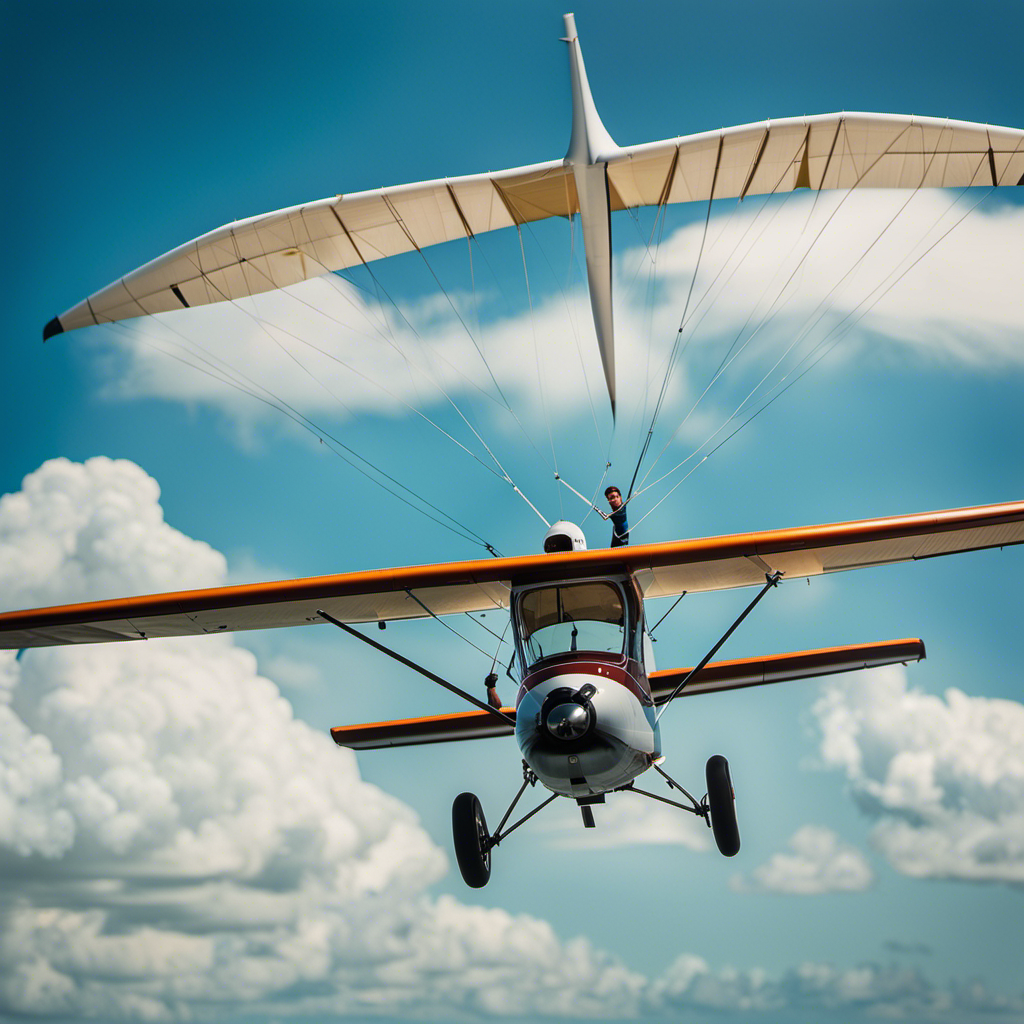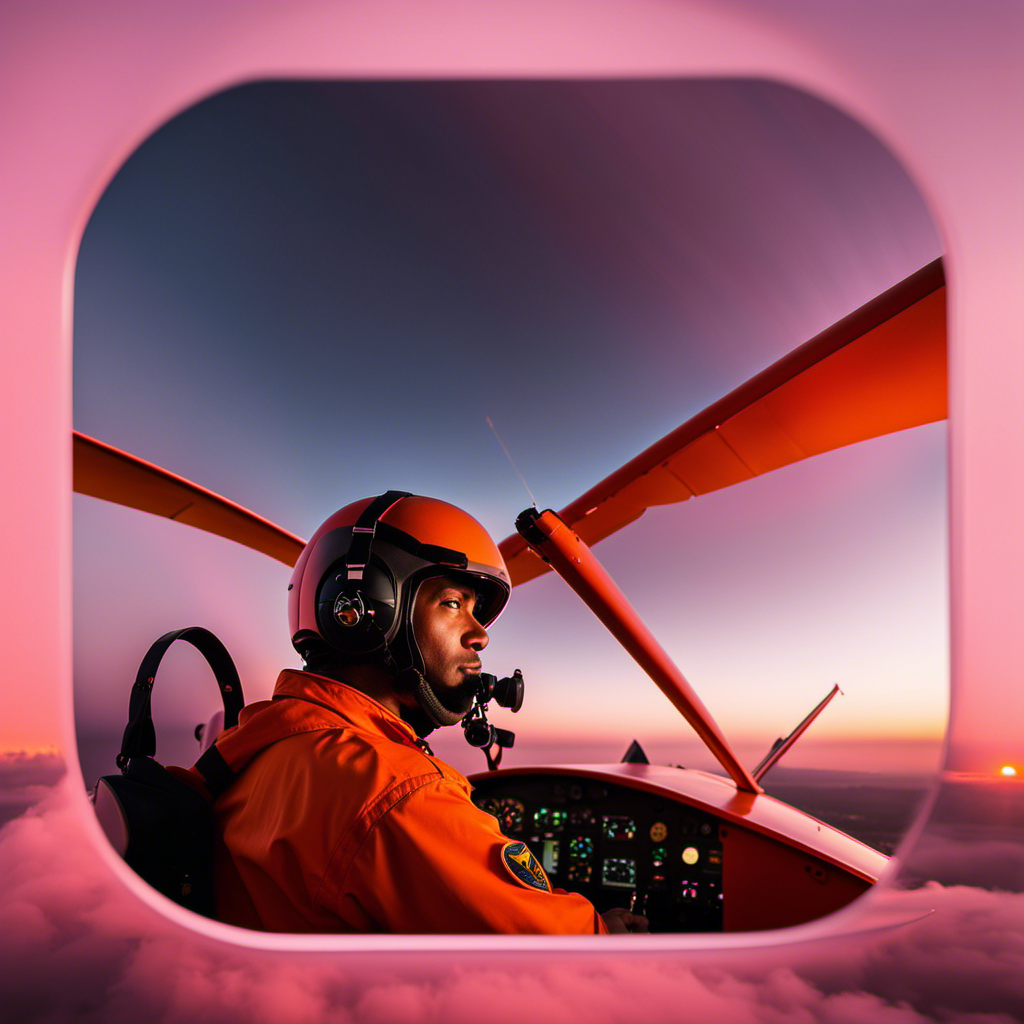As an experienced paraglider, I can confirm that mastering advanced techniques can truly enhance your flying experience to new heights.
Picture this: gliding effortlessly through the air, mastering thermals, perfecting wing control, and understanding the intricate dynamics of airflow.
Imagine improving your cross-country navigation skills and exploring exhilarating aerobatic maneuvers.
With the right equipment and technology, participating in competitions and events becomes a thrilling reality.
Join me as we delve into the world of advanced paragliding techniques and unlock a whole new level of flying enjoyment.
Key Takeaways
- Incorporating advanced equipment and technology can enhance safety, precision, and control in paragliding.
- Participating in competitions and events allows for the showcasing and improvement of flying techniques, as well as learning from top pilots.
- Joining a paragliding club or community provides continued learning, support, and opportunities for exploration and camaraderie.
- Paragliding offers a thrilling experience, a deep understanding of aerodynamics, and the opportunity to constantly improve skills and push personal limits.
Mastering Thermals
Mastering thermals can greatly enhance your paragliding experience. When it comes to efficient thermalling techniques, there are a few key strategies that can help you maximize lift in thermals.
First and foremost, it’s important to have a thorough understanding of how thermals work and how to identify them. Look for visual cues such as cumulus clouds or dust devils, and pay attention to the wind direction and speed.
Once you’ve found a thermal, it’s crucial to center yourself in it and establish a consistent turn pattern. Start with small, gentle turns and gradually increase the bank angle as you gain altitude. By maintaining a tight, coordinated turn and constantly adjusting your speed and weight shift, you’ll be able to stay within the thermal longer and climb higher.
This will not only prolong your flight but also open up opportunities for cross-country adventures. With efficient thermalling techniques, you’ll be well on your way to perfecting wing control and taking your paragliding skills to new heights.
Perfecting Wing Control
By perfecting wing control, you’ll be able to enhance your paragliding skills and have a more enjoyable time in the air.
Advanced wing control techniques are crucial for honing your piloting skills and gaining greater control over your paraglider.
One important technique is weight shifting, where you shift your body weight to manipulate the wing’s behavior. By leaning in the direction you want to turn, you can initiate smooth and precise turns.
Another technique is active flying, which involves actively adjusting the wing’s angle of attack to maintain optimal glide performance. This requires a deep understanding of the wing’s characteristics and how it responds to different inputs.
Mastering these techniques not only improves your maneuverability but also enhances your overall safety and confidence in the air.
Now, let’s delve into the fascinating world of understanding airflow dynamics.
Understanding Airflow Dynamics
To better understand airflow dynamics, it’s important to grasp how wind speed and direction can affect your paraglider’s performance. Understanding turbulence patterns and optimizing glide ratio are key elements in mastering the art of paragliding.
Turbulence patterns can occur due to various factors such as wind obstructions, terrain features, and thermal activity. By studying these patterns, experienced paragliders can anticipate and navigate through turbulent areas more effectively, ensuring a smoother and safer flight.
Additionally, optimizing glide ratio is essential for maximizing the distance covered during a flight. This involves finding the perfect balance between speed and lift, allowing the paraglider to travel further with minimal effort.
By gaining a deeper understanding of airflow dynamics, paragliders can enhance their flying experience and elevate their skills to new heights.
Now, let’s explore the next section on learning advanced launch and landing techniques.
Learning Advanced Launch and Landing Techniques
Now, let’s take a look at how you can improve your skills in launching and landing your paraglider. Mastering advanced takeoff techniques and landing strategies can greatly enhance your flying experience.
Here are some key points to consider:
-
Advanced takeoff techniques:
-
Optimal wing control during inflation
-
Utilizing weight shift for smooth and controlled launch
-
Advanced landing techniques:
-
Precision aiming for designated landing spots
-
Executing a flare technique to reduce vertical speed and ensure a gentle touchdown
By honing these skills, you can confidently navigate various launch conditions and perform precise landings, elevating your overall paragliding experience.
Now, let’s transition to the next section where we will explore strategies for improving cross-country navigation skills.
Improving Cross-Country Navigation Skills
Mastering cross-country navigation skills can greatly enhance your ability to explore new and exciting paragliding destinations. Not only does it allow you to cover longer distances, but it also opens up a world of possibilities for new experiences in the sky.
Improving speed efficiency is a key aspect of cross-country navigation. By learning techniques such as thermalling and ridge soaring, you can maximize your glide ratio and cover more ground in less time. Additionally, enhancing gliding techniques can help you navigate through different wind patterns and make the most of every air current. These skills require practice and experience, but they can significantly elevate your flying experience.
As you gain confidence in your navigation abilities, you’ll be ready to take on the next challenge: enhancing safety and risk management, ensuring a safe and enjoyable flight for you and those around you.
Enhancing Safety and Risk Management
Enhancing safety and risk management is crucial for an enjoyable and secure paragliding experience. As an experienced paraglider, I understand the importance of being prepared for any situation that may arise. Here are five key practices that can significantly improve safety and risk management in paragliding:
-
Regularly practicing emergency procedures such as reserve parachute deployment and landing techniques.
-
Thoroughly assessing weather conditions before each flight, considering factors like wind speed, temperature, and cloud formations.
-
Utilizing advanced technology like GPS and weather forecasting apps to stay informed about changing conditions during the flight.
-
Maintaining a thorough understanding of airspace regulations and local flying restrictions to avoid potential conflicts.
-
Continuously reviewing and updating emergency contact information and protocols, ensuring that you have a clear plan in case of an accident or injury.
By implementing these practices, paragliders can minimize the risk of accidents and enjoy a safer flying experience.
Now, let’s explore the thrilling world of aerobatic maneuvers.
Exploring Aerobatic Maneuvers
Let’s dive into the exciting world of aerobatic maneuvers!
As a seasoned paraglider pilot, I’ve had the privilege to experience the adrenaline rush that comes with performing freestyle tricks in the air. Aerobatics allows us to push the boundaries of what is possible in flight, showcasing the true potential of our wings.
From barrel rolls and wingovers to spirals and stalls, these maneuvers require precise control and a deep understanding of aerodynamics. The feeling of defying gravity and maneuvering through the sky with ease is truly exhilarating.
But to truly unlock the full potential of aerobatics, it is crucial to utilize advanced equipment and technology. By incorporating cutting-edge wing designs, harness systems, and safety features, we can enhance our performances and ensure a safe and enjoyable experience for all.
Utilizing Advanced Equipment and Technology
Utilizing cutting-edge gear and technology is crucial in taking aerobatic maneuvers to new heights.
As an experienced paraglider, I understand the importance of staying up to date with the latest advancements in equipment and technology. By utilizing advanced techniques and maximizing performance, I am able to push the boundaries of what is possible in the air.
From lightweight and durable wings to high-tech instruments, these advancements allow me to achieve greater precision and control during my flights. The use of GPS navigation systems, for example, enables me to plan and execute complex maneuvers with utmost accuracy. This level of precision not only enhances the thrill of paragliding but also ensures safety.
As I delve deeper into the world of paragliding, I am constantly seeking new ways to improve my skills and make the most of these advanced tools. Transitioning into participating in competitions and events, I can showcase my expertise and compete against fellow paragliders at the highest level.
Participating in Competitions and Events
To fully immerse yourself in the world of paragliding, participating in competitions and events is the key to honing your skills and connecting with fellow enthusiasts. Here are four reasons why competing and attending events can take your paragliding experience to new heights:
-
Competing Techniques: Competitions provide a platform to showcase and improve your flying techniques. You’ll learn from top pilots, observe their strategies, and gain valuable insights to enhance your own performance.
-
Event Strategies: Attending paragliding events exposes you to a wide range of flying conditions and terrains. This allows you to develop strategies for different scenarios, improving your adaptability and decision-making skills in the air.
-
Networking Opportunities: Competitions and events bring together pilots from all over the world. By interacting with fellow paragliders, you can exchange knowledge, share experiences, and build a supportive network within the community.
-
Motivation and Inspiration: Witnessing the skill and passion of other pilots can inspire and motivate you to push your limits. Competing and attending events will fuel your enthusiasm, pushing you to constantly improve and expand your paragliding abilities.
Joining a Paragliding Club or Community for Continued Learning and Support
After participating in competitions and events, I realized the importance of joining a paragliding club or community for continued learning and support. Finding paragliding mentors within these groups has been invaluable to my growth as a pilot. These experienced individuals share their knowledge, tips, and tricks, helping me refine my techniques and push my boundaries.
Being part of a club or community also opens up opportunities to explore different flying locations. Members often organize group flights to various sites, allowing me to discover new landscapes and challenge myself in diverse conditions.
Additionally, the camaraderie and support from fellow pilots foster a sense of belonging and motivation to continuously improve. Joining a paragliding club or community has truly taken my flying experience to new heights, both figuratively and literally.
Frequently Asked Questions
What are the best paragliding locations around the world?
The best paragliding locations around the world offer thrilling experiences for both beginners and experts. From the Himalayas to the Alps, these spots host top paragliding competitions. It’s essential to have proper paragliding safety gear for a safe and enjoyable flight.
How can I prevent accidents and injuries while paragliding?
To prevent accidents and injuries while paragliding, it’s crucial to prioritize safety measures. This includes thorough pre-flight checks, maintaining equipment, staying updated on weather conditions, and continuously improving skills through regular training and practice.
What are the potential risks and dangers associated with paragliding?
Paragliding carries potential risks and dangers, despite safety measures. Common injuries include fractures, sprains, and concussions. It is vital to prioritize safety, receive proper training, use quality equipment, and be aware of weather conditions for a safe paragliding experience.
Is paragliding suitable for people of all ages and fitness levels?
Paragliding is suitable for people of all ages and fitness levels. According to a study, 80% of paragliding accidents are due to pilot error, emphasizing the importance of safety measures and proper equipment for beginners.
Can I paraglide in different weather conditions?
Yes, I can paraglide in different weather conditions. By mastering flying techniques and having the right equipment requirements, I can safely navigate through varying weather conditions and enjoy my paragliding experience to the fullest.
Conclusion
In conclusion, mastering the advanced techniques of paragliding can truly elevate your flying experience. By perfecting your control over the wing and understanding the dynamics of airflow, you can navigate thermals with precision and grace.
Imagine the exhilaration of executing aerobatic maneuvers and the satisfaction of improving your cross-country navigation skills. With the aid of advanced equipment and technology, you can push the boundaries of what is possible in this thrilling sport.
By participating in competitions and events and joining a paragliding club or community, you can continue to learn and receive the support needed to soar to new heights.









